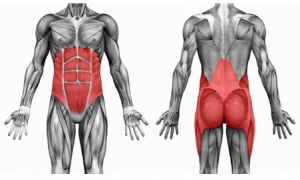What is the core?
The core comprises a system of muscles in the lower trunk area including the lower back, abdomen, and hips. These muscles work together to provide support and mobility and it is in them that all bodily movement, in every conceivable direction, originates.
What are the Core Muscles?
Different experts include different muscles in this list, but in general the muscles of the core run the length of the trunk and torso. The following list includes the most commonly identified core muscles as well as the lesser known groups.
- Rectus Abdominis
- Erector Spinae
- External Obliques
- Internal Obliques
- Transverse Abdominis (TVA)
- Hip Flexors
- Gluteus
 The best core exercises may surprise you. It’s not enough to just do ab crunches and sit ups. To build a strong core you need to exercise a variety of muscles from your hips to your shoulders. Most people think of the core as a nice six-pack, or strong, toned abs, but the truth is that the abdominal muscles are a very small part of the core. The abs have very limited and specific action and what experts refer to as the “core” actually consists of many different muscles that stabilize the spine and pelvis and run the entire length of the torso.
The best core exercises may surprise you. It’s not enough to just do ab crunches and sit ups. To build a strong core you need to exercise a variety of muscles from your hips to your shoulders. Most people think of the core as a nice six-pack, or strong, toned abs, but the truth is that the abdominal muscles are a very small part of the core. The abs have very limited and specific action and what experts refer to as the “core” actually consists of many different muscles that stabilize the spine and pelvis and run the entire length of the torso.
- A Strong Core Reduces Back Pain
Abdominals get all the credit for protecting the back and being the foundation of strength, but they are only a small part of what makes up the core. In fact, it is weak and unbalanced core muscles that are linked to low back pain. Weak core muscles result in a loss of the appropriate lumbar curve and a swayback posture. Stronger and balanced core muscles help maintain appropriate posture and reduce strain on the spine. - A Strong Core Improves Athletic Performance
Because the muscles of the trunk and torso stabilize the spine from the pelvis to the neck and shoulder, they allow the transfer of power to the arms and legs. All powerful movements originate from the center of the body out, and never from the limbs alone. Before any powerful, rapid muscle contractions can occur in the extremities, the spine must be solid and stable and the more stable the core, the most powerful the extremities can contract. - A Strong Core Improves Postural Imbalances
Training the muscles of the core helps correct postural imbalances that can lead to injuries. The biggest benefit of core training is to develop functional fitness; the type of fitness that is essential to daily living and regular activities.
Mike Manoukian

